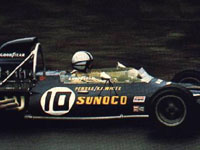America's wonder boy
Author
- Mattijs Diepraam
Date
- 8W December 1998 issue
Related articles
- McLaren M2B - The first steps to a great heritage, by Mattijs Diepraam
- John Watson - King for a day, by Mattijs Diepraam/Martin Zustak
Who?Mark Donohue What?Penske-White Racing McLaren-Cosworth M19A Where?Mosport Park When?1971 Canadian GP |
 |
Why?
In 1971, Mark Donohue was a huge Indy, TransAm, USRRC and CanAm star when Roger Penske entered a semi-works McLaren next to Denny Hulme at the season-closing North American races, replacing Jackie Oliver. His debut came at the Canadian track of Mosport Park.
It was one to remember.
The American qualified as high as 8th and finished the race a tremendous third, the only other driver in the same lap as winner Stewart and runner-up Peterson. He was on for a second appearance at the Glen, but a practice accident saw Mark being replaced by David Hobbs.
His instant F1 success led to no further involvement in the category, Mark instead concentrating on his blossoming Indy career, winning the big one in 1972. His CanAm chores with Penske's Porsche 917/30 came to an early end after a huge shunt mid-season, and Mark saw his Shadow-bound team mate
George Follmer take his first CanAm championship.
A recovered Donohue returned to the tracks in 1973, now taking the CanAm title by storm and
afterwards announcing his retirement. But at the end of 1974 he was lured back into racing by a bullish Roger Penske wanting to do F1 with his own car. So, a Penske with the unusual No.66 was entered at the two North American races, both races largely uneventful for both team and driver.
In 1975, when the team entered its first full season, Penske's chassis again worked no miracles but Mark showed flashes of brilliance, especially at Anderstorp where he took the PC1 up to a fine 5th. Then, as Penske has done regularly in Indycars ever since, the recalcitrant Penske chassis was canned in favour of a customer chassis. In the early seventies this had to be a March.
Its first appearance in Britain proved a success, bringing the Penske team its best qualifying position of the year and two well-earned points. Who knew the same March would be Donohue's death trap just two races later? A bizarre crash in practice for the Austrian GP, when the car flipped over the barrier, killing a marshall and injuring another, spelled the end for a driver who had already retired after winning the 1973 CanAm championship.
Strangely, Mark seemed OK at first. Immediately after the accident he was up and running again but soon after fell unconscious. On the way to Graz hospital it was diagnosed that Donohue had been struck by a brain haemorrhage. He died two days later.
Ironically, Penske's sole win as an F1 constructor came at the same track, John Watson taking his Penske PC4 to an unexpected and highly emotional victory at Zeltweg - exactly one year on.
Reader's Why by Matej Muraus
Mark Donohue began racing at the age of 22 in a 1957 Chevrolet Corvette. He got his big break in 1966 when he was given a ride with Walt Hansgen on John Holman's Ford team in the Daytona Continental and at Sebring, Florida. Donohue and Hansgen finished third in the Continental, second at Sebring.
He was then signed by Roger Penske on a race-by-race basis for the USRRC and Can-Am series in 1966. Donohue won three times on the Can-Am circuit and finished second in the final standings. In 1967, he swept six of eight races to win the USRRC crown and repeated as its champion a year later. That same year, he drove a Camaro to 10 wins in 13 races to take the Trans-Am crown. Donohue went to the Indianapolis 500 for the first time in 1969 and was named rookie of the Year with a fourth-place finish. In 1971, he became the first man to top 180mph in qualifying at Indy with a speed of 185.004 mph, but a faulty gearbox put him out of the race.
In that season he also drove two F1 races - at Canada and USA. In his very first formula 1 race he finished 3rd - a very promising debut! However, he could never repeat that. He came back to Indy in 1972 and this time his luck was all good, as he won with an average speed of 163.465 mph. In 1973, Donohue tried his luck at NASCAR. Armed with an American Motors Matador, he won the season-opening 500-miler on the road course at Riverside, Calif., beating Bobby Allison by a lap and giving American Motors its first NASCAR win.
He was then ultimately dedicated to Formula 1 with the new Penske team, in which he drove in 1974 and 1975, but with no great luck. In 1975 he set the world's close course speed record of 221.160 mph (355.846 km/h) at Alabama International Motor Speedway, but was tragically killed during free practice in the 1975 Austrian GP at the Österreichring. He was known for his turning ability - some people say that is why the tyre burst in the very fast right-hand Hella corner.
